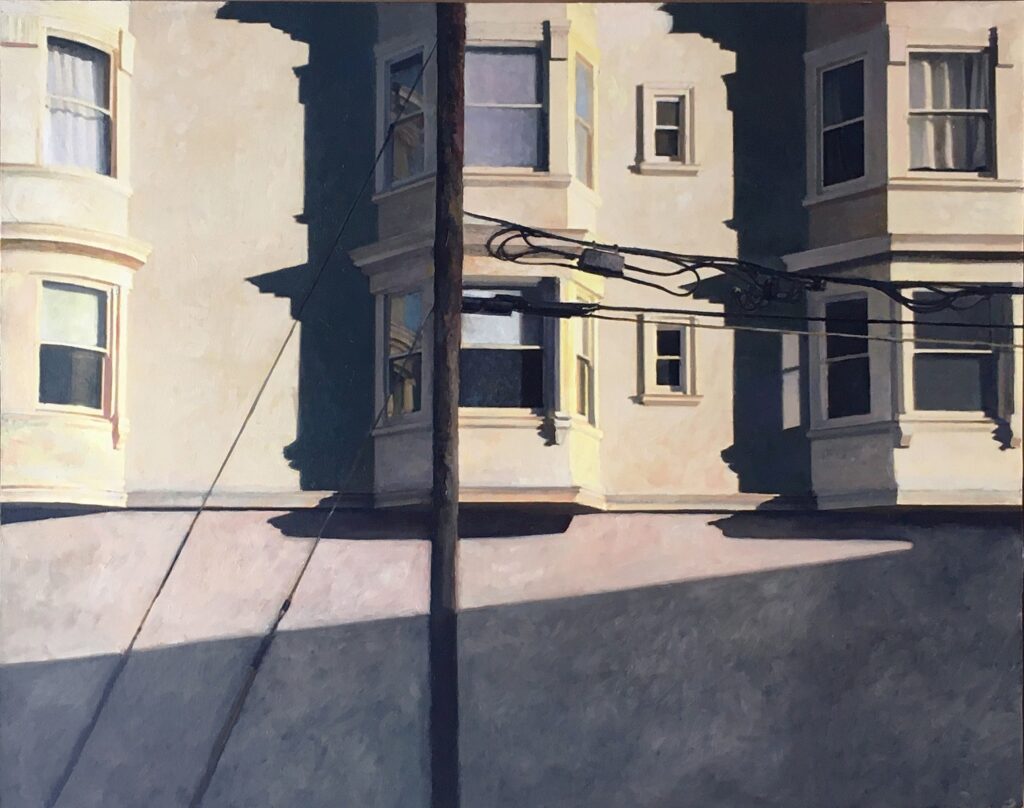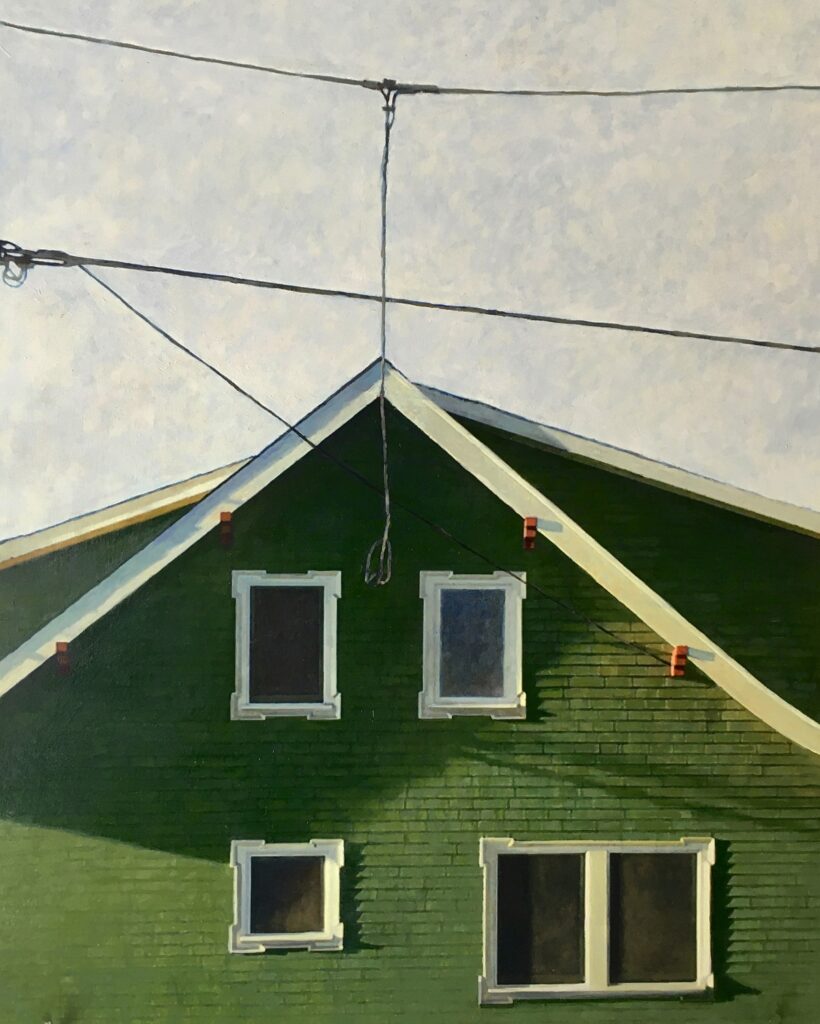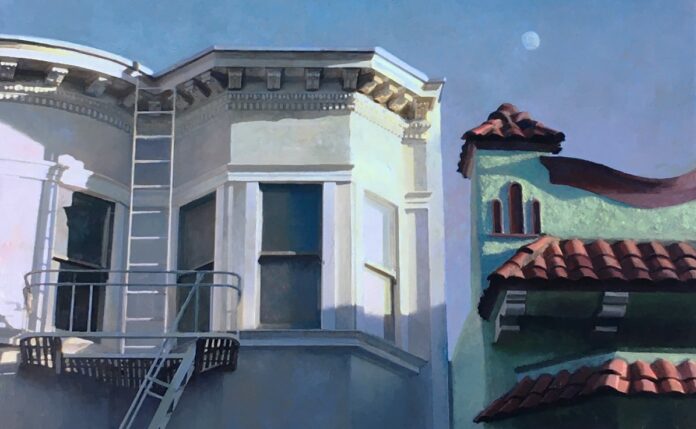If you ask Caren Wynne why she makes art, she will tell you simply that it is in her multifaceted, quiet, and soulful work where she finds herself. This is not to say, however, that she wouldn’t like to find another creative’s passion before her eyes. Because when you follow up with a query about which artist from history she would most like to spend time with, Wynne cites 19th century painter John Singer Sargent.
“I would love to witness his bravura brushwork in real time,” she told 48hills.
Moving to San Francisco in 2009, Wynne currently lives and works in the Lower Haight. The unique architecture along the streets of San Francisco is her subject matter, oils on panel her medium. The City holds memories for her, both happy and sad, and due to this fact, Wynne feels that San Francisco is the perfect place for a melancholy painter.

“There is a lot more going on here than just the postcard good looks,” she said. “Geography and the weather make for dramatic and poetic inspiration.”
Wynne grew up in the Westwood area of Los Angeles, and was accepted into Otis College of Art and Design (aka Otis-Parsons), but couldn’t afford the tuition. Instead, she completed both her BA in drawing and painting and her MA in illustration at California State University-Fullerton.
“Looking back, CSUF was the best experience for me,” she said. “Having to take academic courses alongside art really taught me discipline. I could not get lost in just art, I had to keep my analytical brain going, too.”
Her studies in illustration have served her well. They provided a different atmosphere for the artist; one that was less about emotions and all about technique, and making the best product possible. The program also taught her about time management as it pertained to creative work.
“That has stayed with me,” Wynne said. “There is always a deadline, whether self-imposed or client-driven.”

A day in the studio for Wynne begins at 8am. She works until four or five, taking stretch breaks for 10 minutes every hour and a brief intermission for lunch. Her space is uncluttered so that she can focus on present work.
“I don’t keep any old paintings around, I keep it sparse,” she said. “The only artwork up on the walls is stuff my son did when he was little.”
Keeping up with daily drawing sessions is essential, and she likens the practice to a pianist’s scales or a singer’s vocal exercises. The constant exercise sharpens her ability to see the world that she looks to portray.
“I don’t think it matters whether you paint representationally or abstractly, a daily practice will improve your skills set,” she said.
Photography is also key to her process, and she always has a camera with her, even on the quickest errands. She takes note of visual scenes and returns to them at different parts of the day, sometimes several times, until the setting is perfect.
“Inevitably, a scene you take for granted can turn itself into something special when the light is right,” she said.

An example of this is her painting “Green House.” Wynn visited the location portrayed in the piece often, then played with the images of it that she had captured on Photoshop to omit “the noise,” such as distracting pipes and miscellaneous street detritus. Initially, she creates renderings from her photos in colored pencil to work out the palette of tones. When it comes time to paint, Wynne starts with an undercoat of wild color which helps her to subsequently create the desired effect of glowing light.
“The paintings look really, really odd in the beginning,” she said.
Calling herself “a nervous painter,” Wynne said that every piece is a chance to prove something to herself. When the nerves go away, she knows the painting is done and she has succeeded in her creative quest.
The artist has worked in a hall closet with one window and an outdoor shed whose fabulous light filtered through a plastic corrugated roof. But she calls her current set up ideal.
“With a big north facing room in the front, a wall of windows and high ceilings, I can now paint larger and for longer periods of time,” Wynne said.
Her inspiration comes from a highly personal source: her late husband, Scott. Two months after the couple moved to San Francisco, he was diagnosed with ALS (Lou Gehrig’s disease.)
“For the next 10 years we focused on ALS and raising our young son, each demanding our full attention,” she said. “There was no time for serious painting, really.”
In the early days of her artistic career, Wynne would paint en plein air and sell on-site what she had created. She refers to that initial practice as “guerrilla-style art sales.” When she could no longer be away from the house, she would paint only for Scott, small six-by-six-inch paintings for him to look at while he was at his desk. Wynne was trying to recreate the world which Scott could no longer experience.
Throughout those years, Scott was her biggest cheerleader and supporter—and her harshest critic. In his last years, fully paralyzed, their days were packed with daily challenges. Scott would often ask, “Did you paint today?” and Wynne would reply, “Maybe tomorrow.” It was their way of remembering what normal felt like.
“Scott was the only person who really understood how much I loved painting, how much of my identity was tied up in it,” she said. “If you want to know what drives me, making him proud and being a successful painter, being the painter he knew I could be—that’s it.”

She’s able to give her work more time now, and Wynne treats her art like a start-up business with all-encompassing focus. Wynne sees the arc of her work much as a plot from a book, with a tangible narrative. San Francisco serves as a reliable protagonist, with its light and shadow as the antagonists.
“There is so much of the city I haven’t painted yet,” she said. “I don’t want to repeat myself—that is always in the back of my head when starting a new painting—but I want to further the storyline along.”
Wynne hopes to evoke a sense of time in her work. Though she paints a historic city, she is not interested in portraying the past. She wants us to feel, as viewers of her paintings, as if something is just about to happen within their frame.
Her latest works evoke the city’s unique climate. Coming from Los Angeles, where there is an ever-present haze that dominates the environment, Wynne is deeply impacted by San Franciscan and the ways in which it interacts with the urban environment.
“I remember sitting in my car at a traffic light and seeing big billowy clouds speeding across the intersection and watching how fast clouds move over the city,” she said. “It was something so new and strange.”
She is dedicating a new series to this phenomenon, succinctly named “Fog Paintings.” Wynne is working out scenes in which fog replaces the shadows on the city’s architecture.
“We’ll see if it works!” she said.
Caren Wynne is currently represented by SHOH Gallery in Berkeley and Studio Gallery in San Francisco. For more information, visit her website at halcyonstudios.org and her Instagram profile.






